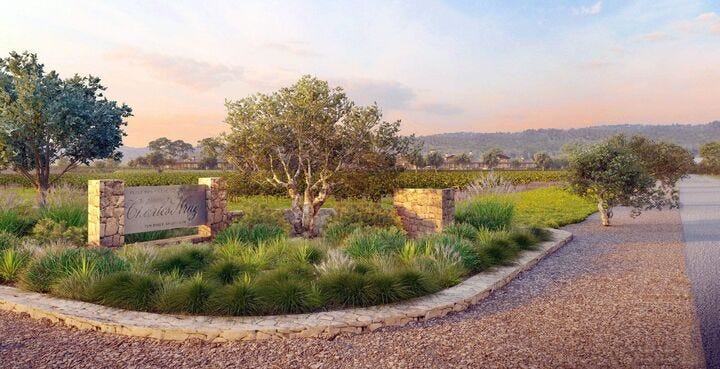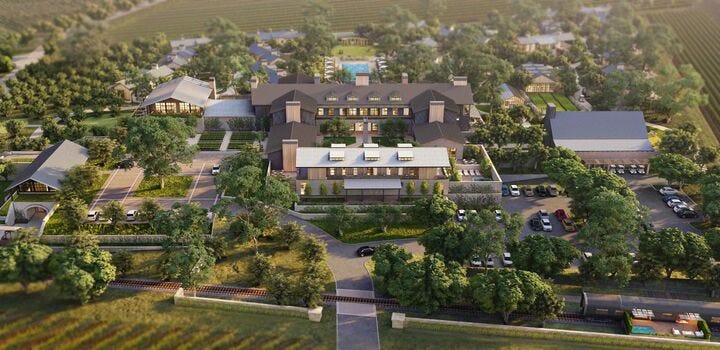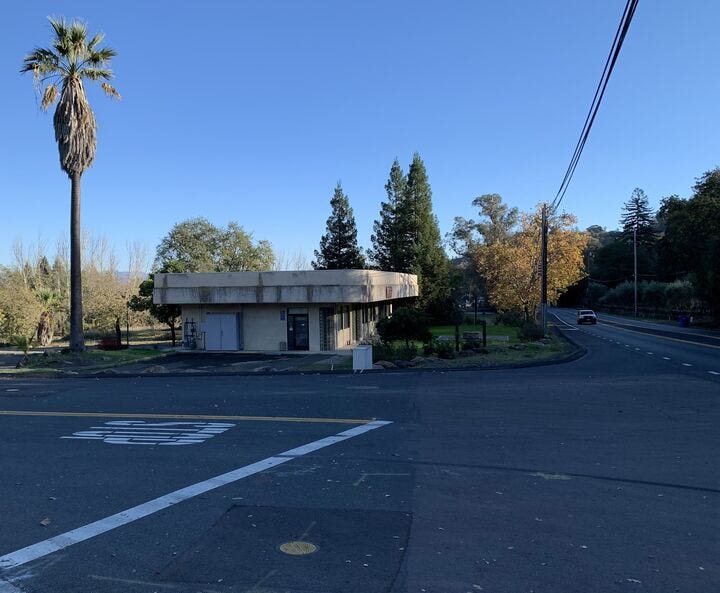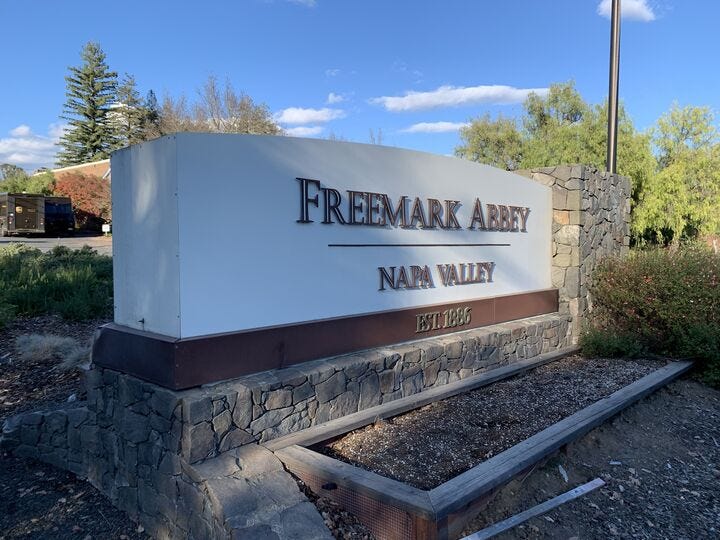NAPA VALLEY, Calif. — For years St. Helenans have debated the value of a hotel on the city-owned Adams Street property. Some thought it was a good use of the land because it would bring in much-needed funds to support city services; others thought it was a shame to change the downtown area with a luxury hotel.

The discussion went on and on with no decisions made, so the land remains vacant.
Now there are three planned hotel developments near St. Helena. One has been approved but is not yet built, and two are in the planning stages.
The St. Helena Planning Commission approved Ted Hall’s lodging plans adjacent to his Farmstead at Long Meadow Ranch restaurant in September 2020, and the city council gave its OK the following month. The plans call for a 65-room single-story hotel in 14 new buildings covering 6.1 acres of the 10-acre site at 1000 Mills Lane. Guests will stay in 10 of the buildings. The new hotel is expected to bring in $2.6 million annually in tax revenue (property taxes and Transient Occupancy Taxes) to the City of St. Helena.
The two in the planning stages are a 52-room resort at Charles Krug Winery, which is in the city limits, and a second one on Highway 29 within the county. This will be the Inn at the Abbey, a 79-room hotel proposed by Jackson Family Investments, owners of Freemark Abbey.
Last month Noble House Hotels & Resort, owners of the Napa Valley Wine Train since 2017, unveiled plans for a 52-room resort on 8.5 acres at the Charles Krug Winery. The winery would enter into a lease agreement with Noble House to build the project. Twelve of the guest rooms would be in a two-story estate house; 38 guest rooms would be located in one- and two-story villa buildings. The remaining two guest rooms would be in historic refurbished train cars on the winery’s 140-acre parcel.
According to the presentation found at sthelenaresort.com, “The project was envisioned in consultation with Charles Krug Winery and the Peter Mondavi Sr. family and fits ideally with the goals of the City of St. Helena’s Financing Civic Infrastructure Task Force, which concluded that two new hotels within St. Helena city limits are essential to create new revenue streams to address the city’s budgetary challenges and finance the city’s many infrastructure needs, which include new city facilities, improvements to streets, sidewalks, and water and wastewater treatments plants.”

It notes that $2.05 million in new annual taxes are anticipated in the first year of operation, which comes from three sources: new property taxes, sales tax revenues from the hotel and its guests, and Transient Occupancy Taxes. By the third year, the revenue is slated to be $3.46 million. The report notes, “This excludes other one-time permitting and impact fees paid as part of the project approval and construction that will provide several million more dollars to the City of St. Helena up-front.”
The Jackson Family has been working on Inn at the Abbey for several years but stalled in the summer of 2020. On Tuesday, Dec. 5, the Napa County Board of Supervisors held the first of several planned public hearings about the project. Other public hearings are for the Napa County Planning Commission (spring/summer 2024) and for final action by the Board of Supervisors (summer/fall 2024).
The owners are seeking a major modification of their use permit, and the development agreement includes nine points.
The proposed project plans are to demolish three buildings, including the long-vacant A Dozen Vintners building on the corner of Lodi Lane and Highway 29 as well as a restaurant and five-room motel. To be built are six new buildings housing a 79-room hotel and associated guest amenities, including a spa with treatment rooms, fitness studio, rooftop lounge and back-of-house uses totaling approximately 78,400 square feet, according to the county’s Initial Study checklist. The hotel rooms would be divided among the six buildings on both sides of Lodi Lane. Other site features would include a parking garage, a swimming pool, a plunge pool and an outdoor lawn area.
On Tuesday the board discussed the nine-point development agreement with Robb Englin, a Napa representative of Jackson Family Investments. Both he and Trevor Hawkes from the county’s Department of Planning, Building & Environmental Services stressed that the hearing was only about the terms of the development agreement, not about the project or the modification of the use permit.

“The board is not in a position to make a decision today,” Englin said, adding that a development agreement is not required but allows a collaborative agreement with the board.
Supervisors were concerned with the Commercial Limited zoning, traffic, water use and the safety of guests crossing Lodi Lane since guest facilities are on both sides.
Two of the nine points in the development agreement addressed affordable housing: Six existing market-rate units will be deed-restricted to be affordable housing for employees, and the developers will make a $1.58 million payment to the county’s affordable-housing trust fund, which is three times what is required. Supervisor Ryan Gregory said Hawkes and county staff should examine the CL zoning to allow the applicant to build more affordable housing.
Englin said building affordable housing is expensive.
“That’s why we’re making a contribution,” he said. “Our project has a lot of review left,” including the preparation of an environmental impact report.
The supervisors all felt that building affordable housing is important. In fact, board chair Belia Ramos said the developers should not pay any money to the county’s affordable-housing trust fund but rather they should make a commitment for actual units of affordable housing.
“Roofs for families are more meaningful to me than dollars,” she said.
In 2004, Yountville’s Bardessono Hotel & Spa did not make a payment to the county’s affordable-housing fund but instead dedicated 1.25 acres of its site. Later Napa Valley Community Housing built 28 units on that land.
The Inn at the Abbey is in Supervisor Anne Cottrell’s district.
“Water and traffic are huge impacts felt by the neighbors,” she said, adding more information will be released when the EIR is done. “I’d like more information about guests and staff crossing Lodi Lane. I have no way to wrap my head around that.”
Ramos, too, said the movement of people between the north and south parcels “makes me incredibly nervous,” adding that lighted signs and safety measures will be needed.
The use of the historic stone building would be changed as the main level would serve as the hotel’s guest lobby, which might include a hotel lounge and retail uses, according to an August 2019 report from Freemark Abbey. The existing winery uses on the cellar level — barrel and wine-bottle storage and wine lab — would become hotel conference spaces.
Currently a draft environmental impact report is in process, and the county has determined the project could have significant effects on the environment in a dozen areas that include air quality and greenhouse-gas emissions; energy, hydrology and water quality; noise, population and housing; transportation/traffic and wildfires.
According to the August 2019 Jackson Family Investments’ request to modify the use permit, the owners of the property have received 20 use-permit revisions since the winery was re-established in July 1965.
Freemark Abbey is one of Napa Valley’s original wineries, founded by Josephine Tychson, who was one of the Napa Valley’s first woman winemakers in the late 1880s. Owners Charles Freeman, Mark Foster and Albert “Abbey” Ahern bought the winery in 1940, and parts of their names make up Freemark Abbey.
Last week
Photojournalist Tim Carl covered Calistoga’s annual Tractor Parade and wrote an interesting piece on the future of Napa Valley, saying it is time to batten down the hatches. John Dunbar reported on Napa’s Economic Outlook Conference, sponsored by the Napa Chamber of Commerce and held at the Silverado Resort. Master Gardener Rainer Hoenicke explained about water’s journey from rooftops to roots, and Virginie Boone profiled Daniel and Sam Baron, the father-and-son team that formed Complant Wines.
Coming up
This week, we’ll have stories from Sasha Paulsen, the Master Gardeners, Lisa Adams Walter and Eduardo Dingler. On Tuesday, Dec. 19, Napa Valley Features will highlight the first of the 13 best-read stories of 2023, which takes us through to Dec. 31. Happy holidays everyone.
Dave Stoneberg is an editor and journalist, who has worked for newspapers in both Lake and Napa counties.






I wonder if the Krug project includes a traffic signal at Deerpark and 29?
Heard that occupancy rate is 40% at hotels in Napa Valley this year. Should we disrupt our lives with more hotels to generate taxes, then the rooms don't fill up??? The income would not be generated to local government ----but public expense and misery to locals will continue.